Celebrating Holy Communion: A Tutorial
A Tutorial with Commentary for United Methodists and other Sacramental Christians
The Sursum Corda
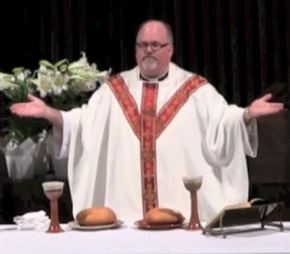
Traditionally, the celebrant opens their arms to the congregation in the universal sign of welcome as they say the words: "The Lord be with you!" This is the ancient liturgical greeting of ministers to the gathered church.
The Lord be with you!
And also with you!
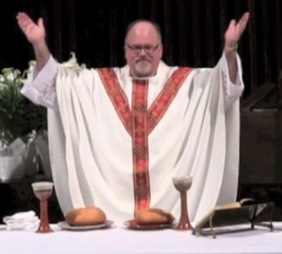
The United Methodist Book of Worship's only recommendation here is: "The pastor may lift hands and keep them raised." ... presumably to the end of the Preface.
Lift up your hearts!
We lift them up to the Lord!
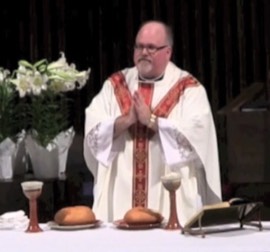
The Untied Methodist Book of Worship doesn't indicate this action, but presumably leaves it open for the celebrant to do so if they wish. When I was in seminary at Duke Divinity School I was taught the traditional motions.
Let us give thanks to the Lord our God!
It is right to give our thanks and praise!
The Preface
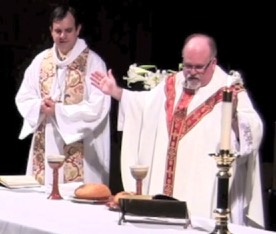
The Preface is usually prayed aloud by the presiding minister. It may be shared, in part or in whole, by a concelebrant (an assisting minister), or by the congregation in unison or antiphonally. For examples of these variations, see Liturgies.
The Preface is the portion of the Great Thanksgiving that is dedicated to the particulars of a given day or season of the Church year. Usually, this portion of the prayer also focuses upon what God has done for us as our creator, and our need of grace.
It is right, and a good and joyful thing, always and everywhere to give thanks to you, Father Almighty, creator of heaven and earth. You formed us in your image and breathed into us the breath of life. When we turned away, and our love failed, your love remained steadfast. You delivered us from captivity, made covenant to be our sovereign God, and spoke to us through your prophets.
The Holy Holy Holy
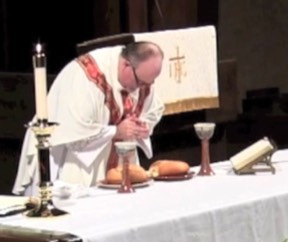
- Bowing the head
- Bowing at the waist (pictured)
- Crossing oneself at "Blessed is he…."
- Going to one knee behind the Table
The first part of the Sanctus (or "Holy") comes from Isaiah 6:3 and Revelation 4:8, where God's throne is described as being surrounded by the six-winged seraphim, who sing praises to Yahweh Elohim. The Benedictus (or "Blessed"), is taken from Matthew 21:9, describing Jesus' Palm Sunday entry into Jerusalem.
Holy, holy, holy Lord,
God of power and might,
heaven and earth are full of your glory,
Hosanna in the highest.
Blessed is he (or the One) who comes in the name of the Lord.
Hosanna in the highest.
The Anamnesis I
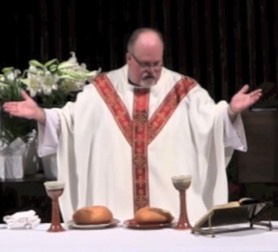
As was true with the Preface, the Anamnesis is usually prayed by the celebrant, but portions may also be shared with a concelebrant and/or prayed by the congregation, either in unison or antiphonally. This portion can be rather lengthy, so care should be taken to not rush through the prayer. Keep in mind that this is a prayer, not a sermon.
According to the Book of Worship, during this portion of the Great Thanksgiving the celebrant usually keeps their hands raised. This is in keeping with the practice of most liturgical Christians.
Holy are you, and blessed is your Son Jesus Christ. Your Spirit anointed him to preach good news to the poor, to proclaim release to the captives and recovering of sight to the blind, to set at liberty those who are oppressed, and to announce that the time had come when you would save your people. He healed the sick, fed the hungry, and ate with sinners. By the baptism of his suffering, death, and resurrection you gave birth to your Church, delivered us from slavery to sin and death, and made with us a new covenant by water and the spirit. When the Lord Jesus ascended he promised to be with us always, in the power of your Word and Holy Spirit.
The Anamnesis II
The Words of Institution
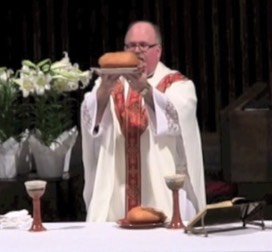
Indeed, these words, or some version of them, are required for Holy Communion to actually be Holy Communion. When clergy try to minimize the liturgy — and this is often seen in Contemporary Worship settings — the "least amount of ritual necessary" for this holy meal to be the Eucharist is the recalling of some version of these words, combined with the praying of some kind of Epicletical prayer (see bellow).
The United Methodist Book of Worship contains the following rubric: "The pastor may hold hands, palms down, over the bread, or touch the bread, or lift the bread." My recommendation is that the bread be lifted to eye-level, holding the plate with both hands, while the Words of Institution regarding the bread are proclaimed. One should not break the bread here; the bread should be broken only after the consecration is completed (i.e., after the Great Thanksgiving and the Lord's Prayer).
On the night in which he gave himself up for us, he took bread, gave thanks to you, broke the bread, gave it to his disciples, and said:
"Take, eat; this is my body which is given for you.
Do this in remembrance of me."
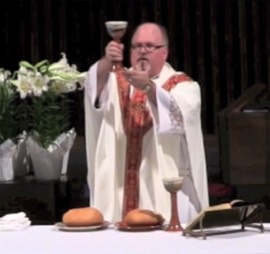
The cup should not be returned to the table until the words of Christ are completed. Motions should be steady and deliberate, and care should be given to not spill the content of the cup. If trays of individual shot-glasses are being used in the sacrament, and a common cup is also present on the Table, it is more effective to only lift the common cup. If there is no common cup, and only trays of shot-glasses are on the Table, lift one of the uncovered trays.
When the supper was over, he took the cup,
gave thanks to you, gave it to his disciples, and said:
"Drink from this, all of you, this is my blood of the new covenant, poured out for you and for many for the forgiveness of sins. Do this, as often as you drink it, in remembrance of me."
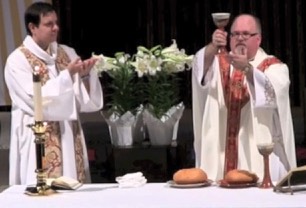
If more than one ordained minster is present and celebrating at the table, it is appropriate to share the presentation of the Words of Institution with them:
- One celebrant can recite the words for the bread while the other takes the words for the cup.
- One can speak the words of narration, while the other recites the words of Christ.
- One may take the lead in presiding, while the other gestures to the lifted elements (pictured)
- If there are more than two pastors concelebrating at the table, it is particularly effective to invite all of them to recite the Words of Institution in unison.
In remembrance of these your mighty acts in Jesus Christ, we offer ourselves in praise and thanksgiving as a holy and living sacrifice, in union with Christ's offering for us, as we proclaim the mystery of faith:
Memorial Acclimation
The Mysterium Fidei
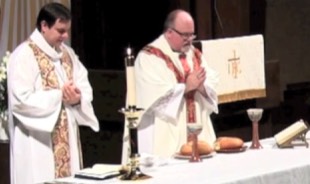
While the United Methodist Book of Worship lacks a rubric at this point to direct the presider's motions, it is appropriate for the celebrant to either clasp their hands or bring them together in an attitude of prayer as the Mystery of Faith is proclaimed (pictured). Alternatively, some traditions have the president make a low bow at the words: "Christ is Risen," reverencing the elements just prior to the epiclesis.
Christ has died;
Christ is risen;
Christ will come again.
Alternative words may be used for the Memorial Acclimation, such as:
We remember his death,
We proclaim his resurrection,
We await his coming in glory.
Or
Dying, Christ destroyed our death!
Rising, Christ restored our life!
Lord Jesus, come in glory.
The Epiclesis
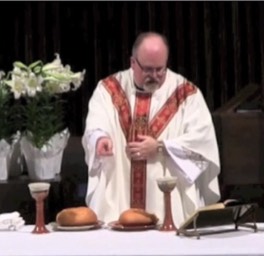
The United Methodist Book of Worship gives a very simple suggestion for celebrants as they pray the epiclesis: "The pastor may hold hands, palms down, over the bread and cup." This action is appropriate and very simple. In my opinion, it is also the very least that should be done while presiding.
In many liturgical traditions it is also appropriate for the celebrant to make the sign of the cross in a horizontal plane over the bread and cup. This can be done most effectively at the very beginning of the epiclesis; as pictured in this photo, the celebrant begins by drawing the vertical bar toward him or herself while saying: "Pour out your Holy Spirit ...."
Pour out your Holy Spirit on us gathered here...
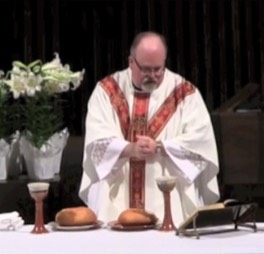
Making the sign of the cross over the elements during the epiclesis is a time honored practice of the church, going back to as early as the 4th Century (and perhaps even earlier). A visual-symbolic proclamation of the death of Jesus, it is appropriate that it be directly connected with the consecration of the bread and wine in the sacrament.
... and on these gifts of bread ...
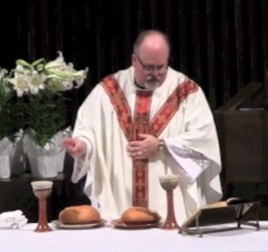
The hand may be held vertically in the horizontal plane, the palm open, with the fingers pointed straight ahead and the thumb folded down over the palm. Alternatively, the index and middle finger can be pointed forward, with the thumb folded down and the ring and pinky fingers folded up so that they touch the thumb.
This latter configuration has the advantage of proclaiming the doctrines of the Holy Trinity and the Consubstantial Humanity and Divinity of Jesus. The Trinity is exemplified by the thumb, ring, and pinky fingers held being held together as symbolizing the unity and diversity of the Father, Son, and Holy Spirit. The Consubstantial Humanity and Divinity of Jesus is similarly exemplified by the index and middle fingers being held together as one, demonstrating that Jesus was both human and divine at the same time.
...and wine.
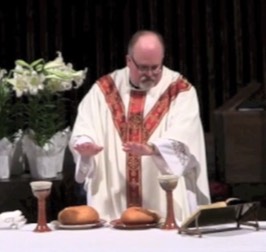
Keep in mind, this is not a magic act: it is a symbolic gesture rooted in multiple Biblical accounts of blessings and consecrations (see, among a great many others, Genesis 48:18-20; Leviticus 1:4; Numbers 8:12; Matthew 19:13-15; 1 Timothy 1:6). When presiding at the Eucharist, and praying the Epiclesis, we are asking God to bless the elements and their receiving; holding one's hands over them at this point simply serves to physically illustrate that for which we are praying.
This can be done in one of several ways:
- Both hands extended side by side, thumbs touching.
- One hand held over the other.
- Both hands cupped, together, over the elements.
- One hand over the elements, the other raised to heaven.
Make them be for us the body and blood of Christ,
that we may be for the world the body of Christ,
redeemed by his blood.
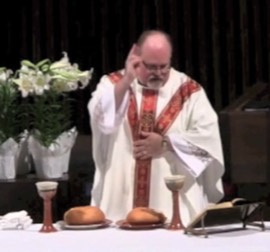
Beginning with "By your Spirit ..." church tradition is open to any one of several actions here. The celebrant may take their pick, keeping in mind that consistency with the prior hand motions over the elements would be especially appropriate:
- The Book of Worship recommends that the celebrant return their hands to the upraised position and keep them there through the rest of the Great Thanksgiving.
- The celebrant may extend their hands, palms outward, toward the congregation in a physical, visible act of blessing.
- The celebrant may make the sign of the cross over the congregation (pictured).
By your Spirit make us one with Christ...
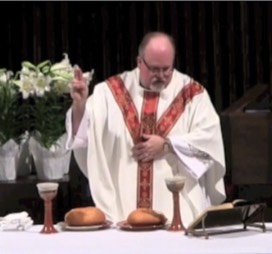
As I proclaim: "... make us one with Christ..." I draw the vertical bar from top to bottom.
As I say: "... one with each other..." I draw the horizontal bar from the left to the right and then back to the center.
... one with each other …
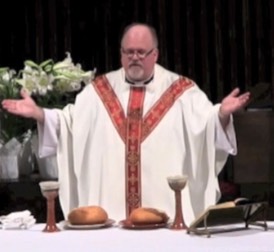
… and one in ministry to all the world, until Christ comes in final victory and we feast at his heavenly banquet.
The Doxology
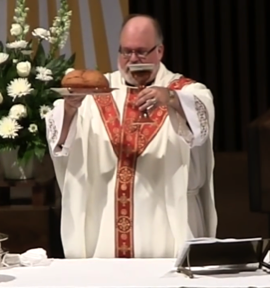
Following the Doxology there is either a said or sung Amen, which brings the Great Thanksgiving to a close.
Through your Son Jesus Christ,
with your Holy Spirit in your Holy Church,
all honor and glory is yours,
Almighty Father, now and forever.
Amen!
The Lord's Prayer
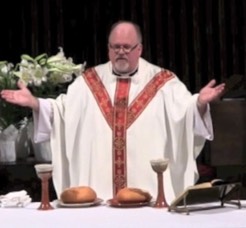
And now, as our savior Christ has taught us, let us pray:
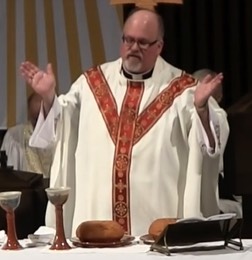
Our Father, who art in heaven, hallowed by thy name. Thy kingdom come, Thy will be done on earth as it is in heaven. Give us this day our daily bread. And forgive us our trespasses, as we forgive those who trespass against us. And lead us not into temptation, but deliver us from evil. For thine is the kingdom, and the power, and the glory, forever. Amen.
The Breaking of the Bread
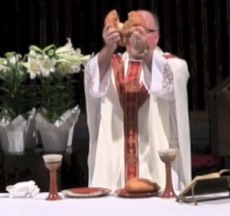
If, rather than a single loaf, wafers are used, the celebrant should consider having a larger "celebrant's host" available to break at this point.
Because there is one loaf
we, though we are many, are one body,
for we all partake the one loaf.
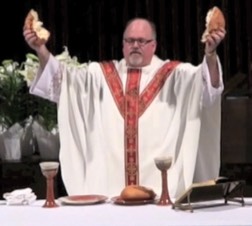
The bread which we break
it is a sharing in the Body of Christ.
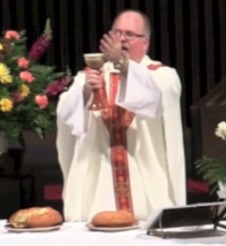
And the cup over which we give thanks
is a sharing in the blood of Christ.
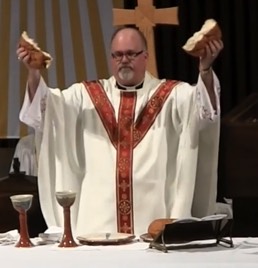
Leader: Alleluia! Christ our passover is sacrificed for us!
People: Therefore let us keep the feast! Alleluia!
This response to the breaking of the bread is particularly effective at Easter, recalling the passover imagery of Good Friday but transformed by the celebration of the Resurrection.
Communion

The Book of Worship, however, leaves this matter open to the preference of the minster and to local custom: "It is traditional that the pastor receive the bread and the cup first and then serve those who are assisting in the giving of the bread and the cup, but, if desired, the pastor and those assisting may receive last."
The historic practice of receiving first come from an understanding of the sacraments as means of grace which one must receive prior to sharing with others. The theological principle is a sound one, but it leaves the presiding minister in a quandary: does one serve themselves in persona Christi (i.e., as if Jesus were serving them), and then commune others? This is the preferred approach in many traditions, however there are plenty of clergy who are uncomfortable with it for multiple reasons.
A popular alternative to serving oneself in persona Christi, while still attempting to abide by the theological principle of first receiving before giving, involves communing just an assistant (for example, a concelebrant), and then receiving communion from that person before proceeding to commune other assistants and the rest of the congregation. This compromise is one that many clergy prefer over serving themselves, and it is the one that I find myself gravitating toward more often than not.
May the Body and the Blood of our Lord Jesus Christ
keep you in everlasting life.
Giving the Bread and the Cup

The Book of Worship is explicit on one point: "All who intend to lead a Christian life, together with their children, are invited to receive the bread and the cup. We have no tradition of refusing any who present themselves desiring to receive." This is what United Methodists call the "Open Table." Clergy are encouraged to make the invitation as clear and as open as possible.
The words used while communing congregants can vary greatly depending upon local custom or preference. In addition to the common one found printed in the Hymnal, the Book of Worship offers several alternatives, including:
The body of Christ, the bread of heaven. Amen!
The blood of Christ, the cup of salvation. Amen!
The body of Christ, given for you.
The blood of Christ, given for you.
The Prayer After Receiving

Eternal God, we give you thanks for this holy mystery in which you have given yourself to us. Grant that we may go into the world in the strength of your Spirit, to give ourselves for others, in the name of Jesus Christ our Lord. Amen.